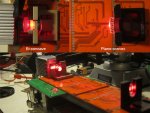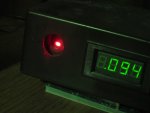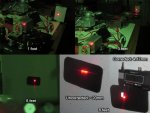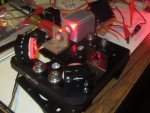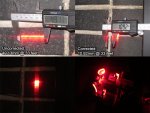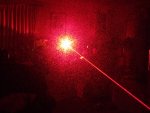- Joined
- Oct 26, 2007
- Messages
- 5,438
- Points
- 83
Problem:
300mW Mitsubishi 635nm laser diode has an extremely wide fast axis as compared to the slow axis. This results in a beam that look extremely wide when the slow axis is focused for infinity, not the nice round dot we come to expect from laser pointers.
Previous solutions:
- Single or double Anamorphic prism pairs - works well, but expensive, or very lossy because the cheap sources (surplus 473nm lasers) are AR coated for IR.
- Cylindrical lenses - Lenses with only one axis that operates as a lens. Works, but where to get them for cheap? Well I found the solution.
After a lot of experimenting I used a pair of cylindrical lenses that I had purchased years ago that came with some optical parts. One is a biconcave cylindrical lens, and also a few plano-convex cylindrical lenses.
The initial setup:

The above jury-rigged setup was the initial experiment and to measure losses of just the optics themselves. You can see the two lenses used. A bi-concave lens sits directly in front of the normal Aixiz-style lens, and a plano-convex lens sits a good distance in front of the bi-concave.
Power measurement:

A 94% transmission rate!
The uncorrected laser output power was initially tuned to 100mW. The above is the power measured after the laser beam passed through the two cylindrical lenses.
New optical setup:

The first setup worked, but was a big pain to get right because nothing was fixed to a stiff surface. So I constructed a more rigid setup with this half-assed "beam table" made of a plate, and some adjustable mirrors I bought some time ago. Note that the lenses were free moving, but at least the mirrors were fixed, as with the laser. Also, the losses were higher in this setup, down to 72%, from all the extra mirrors (despite the mirrors appearing to be coated for 633nm).
Beam shape measurements:

Here you can see the beam shape at various distances, and how it maintains a decent square shape. The beam appears to be corrected by a factor of five (5) in the fast axis.
Long distance measurements:

I brought the correction hardware to a different room to test beam shape at a "long distance" of 33ft. Here you can see that the beam is still quite small, and again, the factor of five reduction in the fast axis. Some distortion is present from the optics, but it is still quite good.
Measurement conclusion:
Definitely not perfect, but quite good nonetheless, and with very good transmitted power. Also cheap (see below).
Obligatory beamshot:

Somehow seeing a red beam is cooler than the other colors. The laser was running at 700mA, which is probably about 500mW I believe.
How much did the optics cost?
Wait for it....
FORTY DOLLARS.
And that's not just for lenses! You get a slew of other good stuff (see below).
Where to get these optics:
Meredith instruments.
Direct link.
Get them while they're hot! Only 44 sets left as of 12/09/2011 and I grabbed another two!
UPDATE: Search for the same sets on Meredith's eBay store for cheaper prices and shipping.
What do you get?
- 1x bi-concave cylindrical lens (coated for red)
- 2x plano-convex cylindrical lenses (each in a different axis, coated for red)
- 1x plano-convex lens (coated for red, different mount)
- 1x plano-convex lens (coated for red)
- 5x Multiple single-axis adjustable mirror mounts (the original reason I bought them). Attached to each respective mount: 2x 633nm dielectric mirrors, 1x 633nm dielectric long mirror, 2x front-surface mirrors (probably good for knife-edging!)
This means you can create your own "beam table" like I showed above! Note that I used some other optics, not the ones in the above link because I don't have any metric screws for them.
Again: $40. Get them while they're hot!
300mW Mitsubishi 635nm laser diode has an extremely wide fast axis as compared to the slow axis. This results in a beam that look extremely wide when the slow axis is focused for infinity, not the nice round dot we come to expect from laser pointers.
Previous solutions:
- Single or double Anamorphic prism pairs - works well, but expensive, or very lossy because the cheap sources (surplus 473nm lasers) are AR coated for IR.
- Cylindrical lenses - Lenses with only one axis that operates as a lens. Works, but where to get them for cheap? Well I found the solution.
After a lot of experimenting I used a pair of cylindrical lenses that I had purchased years ago that came with some optical parts. One is a biconcave cylindrical lens, and also a few plano-convex cylindrical lenses.
The initial setup:
The above jury-rigged setup was the initial experiment and to measure losses of just the optics themselves. You can see the two lenses used. A bi-concave lens sits directly in front of the normal Aixiz-style lens, and a plano-convex lens sits a good distance in front of the bi-concave.
Power measurement:
A 94% transmission rate!
The uncorrected laser output power was initially tuned to 100mW. The above is the power measured after the laser beam passed through the two cylindrical lenses.
New optical setup:
The first setup worked, but was a big pain to get right because nothing was fixed to a stiff surface. So I constructed a more rigid setup with this half-assed "beam table" made of a plate, and some adjustable mirrors I bought some time ago. Note that the lenses were free moving, but at least the mirrors were fixed, as with the laser. Also, the losses were higher in this setup, down to 72%, from all the extra mirrors (despite the mirrors appearing to be coated for 633nm).
Beam shape measurements:
Here you can see the beam shape at various distances, and how it maintains a decent square shape. The beam appears to be corrected by a factor of five (5) in the fast axis.
Long distance measurements:
I brought the correction hardware to a different room to test beam shape at a "long distance" of 33ft. Here you can see that the beam is still quite small, and again, the factor of five reduction in the fast axis. Some distortion is present from the optics, but it is still quite good.
Measurement conclusion:
Definitely not perfect, but quite good nonetheless, and with very good transmitted power. Also cheap (see below).
Obligatory beamshot:
Somehow seeing a red beam is cooler than the other colors. The laser was running at 700mA, which is probably about 500mW I believe.
How much did the optics cost?
Wait for it....
FORTY DOLLARS.
And that's not just for lenses! You get a slew of other good stuff (see below).
Where to get these optics:
Meredith instruments.
Direct link.
Get them while they're hot! Only 44 sets left as of 12/09/2011 and I grabbed another two!
UPDATE: Search for the same sets on Meredith's eBay store for cheaper prices and shipping.
What do you get?
- 1x bi-concave cylindrical lens (coated for red)
- 2x plano-convex cylindrical lenses (each in a different axis, coated for red)
- 1x plano-convex lens (coated for red, different mount)
- 1x plano-convex lens (coated for red)
- 5x Multiple single-axis adjustable mirror mounts (the original reason I bought them). Attached to each respective mount: 2x 633nm dielectric mirrors, 1x 633nm dielectric long mirror, 2x front-surface mirrors (probably good for knife-edging!)
This means you can create your own "beam table" like I showed above! Note that I used some other optics, not the ones in the above link because I don't have any metric screws for them.
Again: $40. Get them while they're hot!
Attachments
Last edited:


